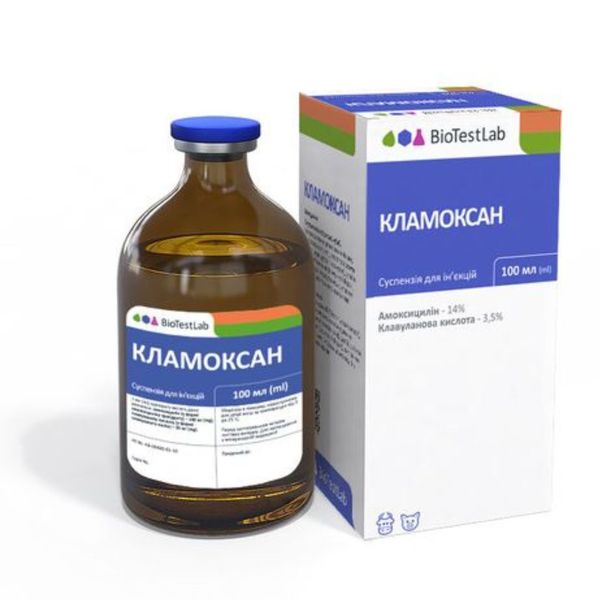|
Quantity
|
Out of stock
|
||
|
|
|||
🐕 CLAMOXAN 🐈 similar SYNULOX
1 ml: Amoxicillin - 140 mg + clavulanic acid - 35 mg
🚑 Dogs and cats: treatment of animals with diseases of the respiratory system (bronchitis, bronchopneumonia, rhinitis), urinary tract (metritis, endometritis, cystitis, urethra, pyelonephritis), joints, skin and soft tissues (umbilical cord infections, wounds, abscesses, pyoderma, bursitis, gingivitis), as well as treatment of animals with leptospirosis, mastitis, actinomycosis, parainfluenza and paratyphoid fever caused by microorganisms sensitive to amoxicillin and clavulanic acid.
🟢 DOSAGE:
Subcutaneously (for dogs and cats) at a dose of 1 ml of the drug per 20 kg of body weight (corresponding to 8.75 mg of active substances per 1 kg of body weight) once a day for 3-5 days. Shake the vial thoroughly before use.
PHARMACOLOGICAL PROPERTIES
🟣 Amoxicillin is a semisynthetic penicillin antibiotic. Its mechanism of action is to disrupt the synthesis of bacterial cell walls, inhibit transpeptidase and carboxypeptidase enzymes, and disrupt the osmotic balance, which leads to the death of bacteria at the growth stage. Amoxicillin has a broad spectrum of activity against Gram-positive and Gram-negative microorganisms, such as: Staphylococcus spp., Streptococcus, spp. (S.agalactiae, S.dysgalactiae, S.uberis), E.coli, Arcanobacteria (including A.pyogenes), Corynebacteria spp., Clostridia spp., Bacillus anthracis, Actinomyces bovis, Bacillus cereus, Bacteroides (including β-lactamase-producing strains), Campylobacter spp., Klebsiella spp., Pasteurella spp., Escherichia coli, Salmonella spp., Proteus spp., Fusobacterium necrophorum, Haemophilus spp., Moraxella spp., Actinobacillus lignieresii. 🟣 Clavulanic acid is one of the natural metabolites of Streptomyces clavuligerus. It resembles penicillin because it has a structurally similar core with a β-lactam ring. Clavulanic acid is an inhibitor of the β-lactamase enzyme, the action of which is initially active and eventually inactivated. Clavulanic acid penetrates the bacterial cell wall and binds external and intracellular β-lactamase enzymes.
Amoxicillin in combination with an inhibitor of this enzyme (clavulanic acid) broadens the spectrum of antibacterial action.
⚠ Contraindications:
Hypersensitivity to amoxicillin and clavulanic acid.
The drug should not be used in rabbits, guinea pigs, hamsters and other small herbivores.
Do not use in animals with impaired renal function.
Do not use concurrently with antibiotics from the cephalosporin, tetracycline, macrolide and sulfonamide groups.
⚠ Do not administer intravenously.
Reservations:
Side effect
In some cases, a painful reaction or a local reaction in the form of swelling may be observed after administration of the drug. Sometimes short-term digestive disorders (nausea, diarrhea), transferable to each other, allergic reactions, anaphylaxis are possible. If one of the symptoms appears, the drug should be discontinued and symptomatic treatment should be carried out. In the event of allergic reactions, it is advisable to administer corticosteroids and adrenaline to the animals.
Storage:
A dry, dark place inaccessible to children at a temperature of 4 to 25 ° C.
Best before the date
24 months from the date of production.

































